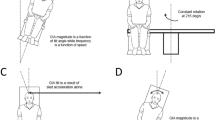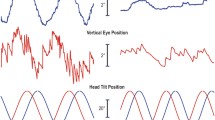Abstract
Sinusoidal translation while rotating at constant angular velocity about a vertical axis (translation while rotating, TWR) produces centripetal and translational accelerations along the direction of translation and an orthogonal Coriolis acceleration due to the translation in the rotating frame. Thus, a Coriolis acceleration is produced along the bitemporal axis when oscillating along the naso-occipital axis, and along the naso-occipital axis when oscillating along the bitemporal axis. Together, these components generate an elliptically rotating acceleration vector that revolves around the head in the direction of rotation at the frequency of oscillation. Here we studied the orienting and compensatory responses of rabbits during TWR. Combinations of centripetal and translational accelerations were held constant at 0.5 g, and oscillation frequencies were varied from 0.01–0.33 Hz. The amplitude of the Coriolis acceleration increased with the frequency of translation. Naso-occipital translation caused vergence and pitch at all frequencies and roll at higher frequencies, and bitemporal translation produced roll at all frequencies and vergence and pitch at higher frequencies. The sensitivity of each ocular orienting component to linear acceleration was comparable across the different oscillation frequencies. TWR also induced continuous yaw nystagmus with slow phase velocity in the direction of rotation of the acceleration vector. Thresholds for appearance of nystagmus were 0.05 Hz, corresponding to a Coriolis acceleration of 0.06 g. Mean slow phase velocity for a rotating linear acceleration vector produced by 0.5 g along the translation axis and 0.34 g of Coriolis acceleration along the orthogonal axis were ≈9°/s. Eye velocities during TWR were similar to those generated by off-vertical axis rotation (OVAR), but were opposite in direction with regard to head rotation, following the direction of the rotating acceleration vector in both paradigms. Both are produced by activation of velocity storage in the vestibular system. One important difference between TWR and OVAR is that the head is always upright with regard to gravity during TWR. We speculate that the brain may use these low amplitude rotating linear accelerations to generate eye velocities that help to orient gaze when making turns during normal locomotion.






Similar content being viewed by others
References
Angelaki DE, Hess BJM (1996) Three-dimensional organization of otolith-ocular reflexes in rhesus monkeys. I. Linear acceleration responses during off-vertical axis rotation. J Neurophysiol 75:2405–2424
Angelaki DE, McHenry MQ, Dickman JD, Newlands SD, Hess BJM (1999) Computation of inertial motion: neural strategies to resolve ambiguous otolith information. J Neurosci 19:316–327
Baarsma EA, Collewijn H (1975) Eye movements due to linear acceleration in the rabbit. J Physiol 245:227–247
Benjamins CE (1918) Contribution á la connaissance des réflexex toniques des muscles de l’oeil. Archives Neerlandaises de Physiologie de l’Homme et des Animaux 2:536–544
Benson AJ, Bodin MA (1966) Interaction of linear and angular acceleration on vestibular receptors in man. Aerosp Med 37:144–154
Clement G, Moore ST, Raphan T, Cohen B (2001) Perception of tilt (somatogravic illusion) in response to sustained linear acceleration during space flight. Exp Brain Res 138:410–418
Cohen B, Suzuki JI, Raphan T (1983) Role of the otolith organs in generation of horizontal nystagmus: effects of selective labyrinthine lesions. Brain Res 276:159–164
Cohen B, Maruta, J, Raphan T (2001) Orientation of the eyes to gravitational acceleration. Ann N Y Acad Sci 942:241–258
Collewijn H, Noorduin H (1972) Conjugate and disjunctive optokinetic eye movements in the rabbit, evoked by rotatory and translatatory motion. Pflügers Arch 335:173–185
Dai M, McGarvie L, Kozlovskaya I, Raphan T, Cohen B (1994) Effects of spaceflight on ocular counterrolling and the spatial orientation of the vestibular system. Exp Brain Res 102:45–56
Fuller JH (1980) Linkage of eye and head movements in the alert rabbit. Brain Res 194:219–222
Guedry FE (1965) Orientation of the rotation-axis relative to gravity: its influence on nystagmus and the sensation of rotation. Acta Otolaryngol 60:30–48
Högyes A (1881) Über den Nervenmechanismus der assoziierten Augenbewegungen (1912 Monatsschrift Fuer Ohrenheilkunde 46:685–740 in German)
Hughes A (1971) Topographical relationships between the anatomy and physiology of the rabbit visual system. Documenta Ophthal 30:30–159
Imai T, Moore ST, Raphan R, Cohen B (2001) Interaction of the body, head, and eyes during walking and turning. Exp Brain Res 136:1–18
Jones GE, Balaban CD, Jackson RL, Wood KA, Kopke RD (2003) Effect of trans-bullar gentamicin treatment on guinea pig angular and linear vestibulo-ocular reflexes. Exp Brain Res 152:293–306
Kushiro K, Dai M, Kunin M, Yakushin SB, Cohen B, Raphan T (2002) Compensatory and orienting eye movements induced by off-vertical axis rotation (OVAR) in monkeys. J Neurophysiol 88:2445–2462
Lansberg MP, Guedry FE, Graybiel A (1965) Effect of changing the resultant linear acceleration relative to the subject on nystagmus generated by angular acceleration. Aerosp Med 36:456–460
Lorente de Nó R (1926) Die Gundlagen der Labyrinthphysiologie. Skandinavisches Archiv fur Physiologie 49:251–311
Lorente de Nó R (1932) The regulation of eye positions and movements induced by the labyrinth. Larngoscope 42:233–332
Magnus R (1924) Körperstellung [Body posture]. Verlag von Julius Springer Berlin
Maruta J, Simpson JI, Raphan T, Cohen B (2001) Orienting otolith-ocular reflexes in the rabbit during static and dynamic tilts and off-vertical axis rotation (OVAR) Vision Res 41:3253–3268
Maruta J, MacDougall HG, Simpson JI, Raphan T, Cohen B (2004) Temporal-nasal asymmetry of the vestibulo-ocular reflex (VOR) in the rabbit. Soc Neurosci Abst 30:411.9
Mayne RA (1974) A systems concept of the vestibular organs. In: Kornhuber HH (ed) Vestibular system. Handbook of sensory physiology, vol VI/2. Springer, Berlin, Heidelberg, New York, pp 493–580
Merfeld DM (1995) Modeling the vestibulo-ocular reflex of the squirrel monkey during eccentric rotation and roll tilt. Exp Brain Res 106:123–134
Moore ST, Clément G Raphan T, Cohen B (2001) Ocular counterrolling induced by centrifugation during orbital space flight. Exp Brain Res 137:323–335
Niven JI, Hixon WC, Correia MJ (1966) Elicitation of horizontal nystagmus by periodic linear acceleration. Acta Otolaryngol 62:429–441
Oyster CW (1968) The analysis of image motion by the rabbit retina. J Physiol 199:613–635
Paige GD (1983) Vestibuloocular reflex and its interactions with visual following mechanisms in the squirrel monkey. I. Response characteristics in normal animals. J Neurophysiol 49:134–150
Paige GD, Seidman SH (1999) Characteristics of the VOR in response to linear acceleration. Ann N Y Acad Sci 871:123–135
Paige GD, Tomko DL (1991) Eye movement responses to linear head motion in the squirrel monkey. I. Basic Characteristics. J Neurophysiol 65:1170–1182
Pastor AM, De La Cruz RR, Baker R (1992) Characterization and adaptive modification of the goldfish vestibuloocular reflex by sinusoidal and velocity step vestibular stimulatio. J Neurophys 68:2003–2015
Raphan T, Cohen B (2002) The vestibulo-ocular reflex in three dimensions. Exp Brain Res 145:1–27
Raphan T, Cohen B, Henn V (1981) Effects of gravity on rotatory nystagmus in monkeys. Ann N Y Acad Sci 374:44–55
Schwartz U, Busettini C, Miles FA (1989) Ocular responses to linear motion are inversely proportional to viewing distance. Science 245:1394–1396
Seidman SH, Paige GD (1996) Perception and eye movement during low-frequency centripetal acceleration. Ann N Y Acad Sci 781:693–695
Seidman SH, Telford L, Paige GD (1998) Tilt perception during dynamic linear acceleration. Exp Brain Res 119:307–314
Simpson JI (1983) Transformations of coordinates intrinsic to the vestibulo-ocular reflex. Soc Neurosci Abst 9:95.4
Simpson JI, Leonard CS, Soodak RE (1988) The accessory optic system of rabbit. II. Spatial organization of direction selectivity. J Neurophysiol 60:2055–2072
Singh A, Thau, FE, Raphan T, Cohen B (1981) Detection of saccades by a maximum likelihood ration criterion. In: 34 ACEMB, Houston, TX, p136
Tan HS, van der Steen J, Simpson JI, Collewijn H (1993) Three-dimensional organization of optokinetic responses in the rabbit. J Neurophysiol 69:303–317
Telford L, Seidman SH, Paige GD (1996) Canal-otolith interactions driving vertical and horizontal eye movements in the squirrel monkey. Exp Brain Res 109:407–418
Telford L, Seidman SH, Paige GD (1997) Dynamics of squirrel monkey linear vestibuloocular reflex and interactions with fixation distance. J Neurophysiol 78:1775–1790
Van der Hoeve J, De Keijn A (1917) Tonische labyrinthreflexe auf die augen. Pfügers Archiv fuer die gesamte Physiologie des Menschen und der Tiere 169:241–262
Wearne S, Raphan T, Cohen B (1998) Control of spatial orientation of the angular vestibuloocular reflex by the nodulus and uvula. J Neurophysiol 79:2690–2715
Woellner RC, Grabiel A (1959) Counterrolling of the eyes and its dependence on the magnitude of gravitational or inertial force acting laterally on the body. J Appl Physiol 14:632–634
Young LR, Henn V (1975) Nystagmus induced by pitch and yaw rotation of monkeys. Fortschr Zool 23:235–246
Acknowledgements
The authors wish to thank Victor Rodriguez and Dmitri Ogorodnikov for technical assistance. This work was supported by DC03284, EY011812, EY04148, EY01867 and NS13742.
Author information
Authors and Affiliations
Corresponding author
Rights and permissions
About this article
Cite this article
Maruta, J., Simpson, J.I., Raphan, T. et al. Orienting eye movements and nystagmus produced by translation while rotating (TWR). Exp Brain Res 163, 273–283 (2005). https://doi.org/10.1007/s00221-004-2178-5
Received:
Accepted:
Published:
Issue Date:
DOI: https://doi.org/10.1007/s00221-004-2178-5




